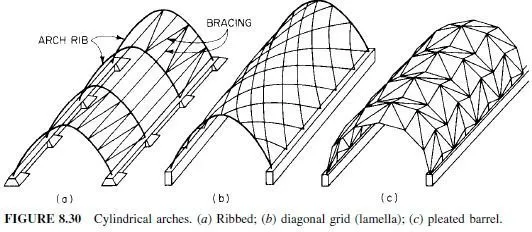Principal parts of a highway truss bridge are indicated in Fig. 13.1; those of a railroad truss are shown in Fig. 13.2.
Joints are intersections of truss members. Joints along upper and lower chords often are referred to as panel points. To minimize bending stresses in truss members, live loads generally are transmitted floor framing to the panel points of either chord in older,
shorter-span trusses. Bending stresses in members due to their own weight was often ignored in the past. In modern trusses, bending due to the weight of the members should be considered.
Chords are top and bottom members that act like the flanges of a beam. They resist the tensile and compressive forces induced by bending. In a constant-depth truss, chords are essentially parallel. They may, however, range in profile from nearly horizontal in a moderately variable-depth truss to nearly parabolic in a bowstring truss. Variable depth often improves economy by reducing stresses where chords are more highly loaded, around midspan in simple-span trusses and in the vicinity of the supports in continuous trusses.
Web members consist of diagonals and also often of verticals. Where the chords are essentially parallel, diagonals provide the required shear capacity. Verticals carry shear, provide
additional panel points for introduction of loads, and reduce the span of the chords under dead-load bending. When subjected to compression, verticals often are called posts, and when subjected to tension, hangers. Usually, deck loads are transmitted to the trusses through end connections of floorbeams to the verticals.
Counters, which are found on many older truss bridges still in service, are a pair of diagonals placed in a truss panel, in the form of an X, where a single diagonal would be subjected to stress reversals. Counters were common in the past in short-span trusses. Such short-span trusses are no longer economical and have been virtually totally supplanted by beam and girder spans. X pairs are still used in lateral trusses, sway frames and portals, but are seldom designed to act as true counters, on the assumption that only one counter acts at a time and carries the maximum panel shear in tension. This implies that the companion counter takes little load because it buckles. In modern design, counters are seldom used in the primary trusses. Even in lateral trusses, sway frames, and portals, X-shaped trusses are usually comprised of rigid members, that is, members that will not buckle. If adjustable counters are used, only one may be placed in each truss panel, and it should have open turnbuckles. AASHTO LRFD specifies that counters be avoided. The commentary to that provision contains reference to the historical initial force requirement of 10 kips. Design of such members by AASHTO SLD or LFD Specifications should include an allowance of 10 kips for initial stress. Sleeve nuts and loop bars should not be used.

End posts are compression members at supports of simple-span tusses. Wherever practical, trusses should have inclined end posts. Laterally unsupported hip joints should not be used.
Working lines are straight lines between intersections of truss members. To avoid bending stresses due to eccentricity, the gravity axes of truss members should lie on working lines.
Some eccentricity may be permitted, however, to counteract dead-load bending stresses.
Furthermore, at joints, gravity axes should intersect at a point. If an eccentric connection is unavoidable, the additional bending caused by the eccentricity should be included in the design of the members utilizing appropriate interaction equations.
AASHTO Specifications require that members be symmetrical about the central plane of a truss. They should be proportioned so that the gravity axis of each section lies as nearly as practicable in its center.
Connections may be made with welds or high-strength bolts. AREMA practice, however, excludes field welding, except for minor connections that do not support live load.
The deck is the structural element providing direct support for vehicular loads. Where the deck is located near the bottom chords (through spans), it should be supported by only two trusses.
Floorbeams should be set normal or transverse to the direction of traffic. They and their connections should be designed to transmit the deck loads to the trusses.
Stringers are longitudinal beams, set parallel to the direction of traffic. They are used to transmit the deck loads to the floorbeams. If stringers are not used, the deck must be designed to transmit vehicular loads to the floorbeams.
Lateral bracing should extend between top chords and between bottom chords of the two trusses. This bracing normally consists of trusses placed in the planes of the chords to provide stability and lateral resistance to wind. Trusses should be spaced sufficiently far apart to preclude overturning by design lateral forces.
Sway bracing may be inserted between truss verticals to provide lateral resistance in vertical planes. Where the deck is located near the bottom chords, such bracing, placed between truss tops, must be kept shallow enough to provide adequate clearance for passage of traffic below it. Where the deck is located near the top chords, sway bracing should extend in full-depth of the trusses.
Portal bracing is sway bracing placed in the plane of end posts. In addition to serving the normal function of sway bracing, portal bracing also transmits loads in the top lateral bracing to the end posts (Art. 13.6).
Skewed bridges are structures supported on piers that are not perpendicular to the planes of the trusses. The skew angle is the angle between the transverse centerline of bearings and a line perpendicular to the longitudinal centerline of the bridge.



